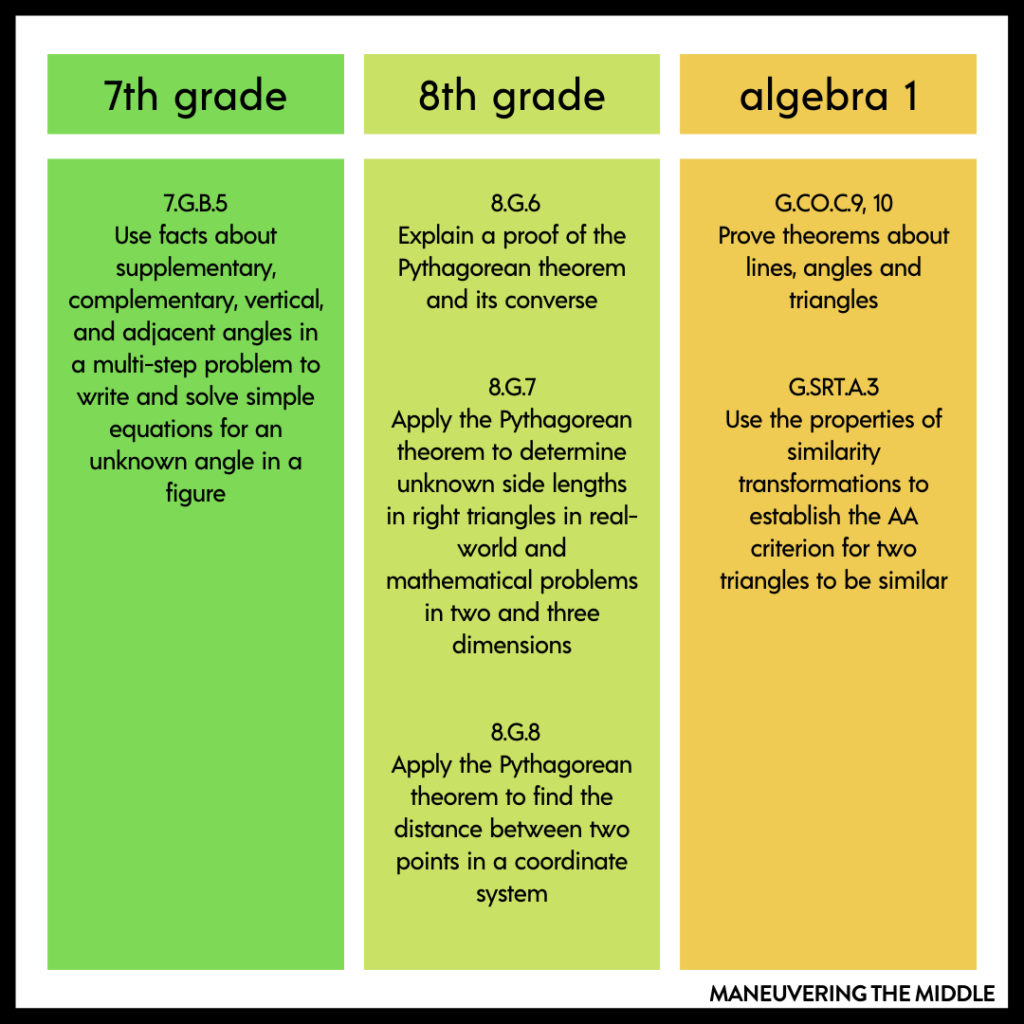Let’s talk about my favorite theorem, Pythagorean’s! Though it ranked 4 out of 100 in mathematicians, Paul and Jack Abad’s, list of 100 Greatest Theorems, I know it ranks number 1 in most middle school math teachers’ hearts.

Vertical Alignment
Before I jump into any topic, I like to see what students already know. Our units are complete with vertical planning, so I don’t have to search far to see that students have used equations to solve for unknown angles. Now we just need to make the jump to side lengths!

Plethora of Hook Opportunities

There are so many compelling ways to introduce Pythagorean Theorem to your students. In fact, the more context and real-world examples you can provide about the math they are learning, the more investment your students will have.
This Who Wants to Be a Millionaire video clip is kind of silly, but is a short and easy way to exclaim, “YOU MIGHT BE ASKED THIS ON A GAME SHOW FOR MONEY” or more likely, be asked on the street by someone making a video for TikTok.
Day Mayer’s Three Act – The Taco Cart was recommended by many teachers in a Middle School Math Facebook group. I would show the first video and present it as, “By the end of this unit, you will be able to solve this problem.” This Desmos Adaptation is a great digital version.
Go Hands-On
Pythagorean Theorem is incredibly visual, but it is also incredibly kinetic. Let’s encourage students to manipulate and play to develop an understanding of how and why the Pythagorean Theorem works. You can do this in a variety of ways:
- Cheez Its or Starbursts

- Graph Paper – This PBS website gives you an outline on how to do this.
- Pythagorean Theorem Intro Activity – Another way students can “see” the theorem in action.
Know the Parts
One of the most common misconceptions students will face is identifying the legs and the hypotenuse on a triangle especially when the triangle is orientated in a different way.
Provide ample opportunities for students to label and annotate the right triangle before moving onto any calculations. Here is a non-exhaustive list of all the ways to help students labeling parts correctly:
- Start with the parts in the formula before using variables
- hypotenuse^2 = leg ^2 + leg ^2

- Hypotenuse is the longest word and therefore the longest side
- Have students draw an arrow directly across the right angle (like I did in pink above) to the hypotenuse and label it first thing as hypotenuse = c first! This reinforces the idea that students should double check that it is a right angle before assuming it is a right angle.
- If a student feels hung up on the orientation of a right triangle (because it isn’t “right”), encourage students to turn their paper until the right triangle looks “right” to them.
Practice, Practice, Practice
There is a hierarchy of math practice. Students need to build up fluency, so they are able to tackle the more complex problem types. If they can’t square a number, take a square root of a number, or solve an equation for a variable, then they will struggle to solve application problems involving Pythagorean Theorem.
Pythagorean Theorem Maze Practice – This practice is scaffolded. One maze uses solely whole numbers, and then students can move on to problems involving rational numbers.
Pythagorean Theorem He Said, She Said Activity – Error analysis is beneficial for procedural and conceptual understanding. It allows students to think behind the HOW and into the WHY. These types of problems are great for partner work and encourage mathematical discourse.
Pythagorean Theorem Performance Task – If you are looking for an alternative to a unit test, may I recommend this math task? It provides multiple opportunities to show mastery of the Pythagorean Theorem, and it will encourage students to use multiple strategies of problem solving. What is the task? Students must design the layout of various attractions at a Harvest Festival. If you haven’t assigned a performance task in your classroom, be sure to check out these performance tasks tips and tricks.

Other Pythagorean Theorem Tips
- Does this side length make sense? Reasonableness is always something to be challenging students to consider. This develops their number sense (which is important when 8th graders are using calculators). When students are solving equations that are multi-step, I find that students can get so excited they leave off the last step. In the case of the Pythagorean Theorem, it is taking the final square root. I like to faux forget the last step and box my answer and wait for students to call me out! Then I would ask, “Does this answer make sense?” If I have side lengths of 12 and 9 inches, would the last side make sense at 225 inches?
- Posting an anchor chart of perfect squares can be a great way to reinforce students memorizing perfect squares. If students quickly know these math facts it will serve them well in Algebra 1, so this is a great time to work on that skill. Our 8th Grade Math and Algebra 1 Fast Pass have a list of perfect squares, so download the freebie and give it to your students to reference.
What tips do you have for teaching Pythagorean Theorem?






Thanks so much for sharing your ideas, resources, and knowledge with us! I love how you present ideas to us in multiple modalities, such as hands-on ideas along with technology to incorporate. The vertical alignment is a valuable tool for planning. Thanks again!